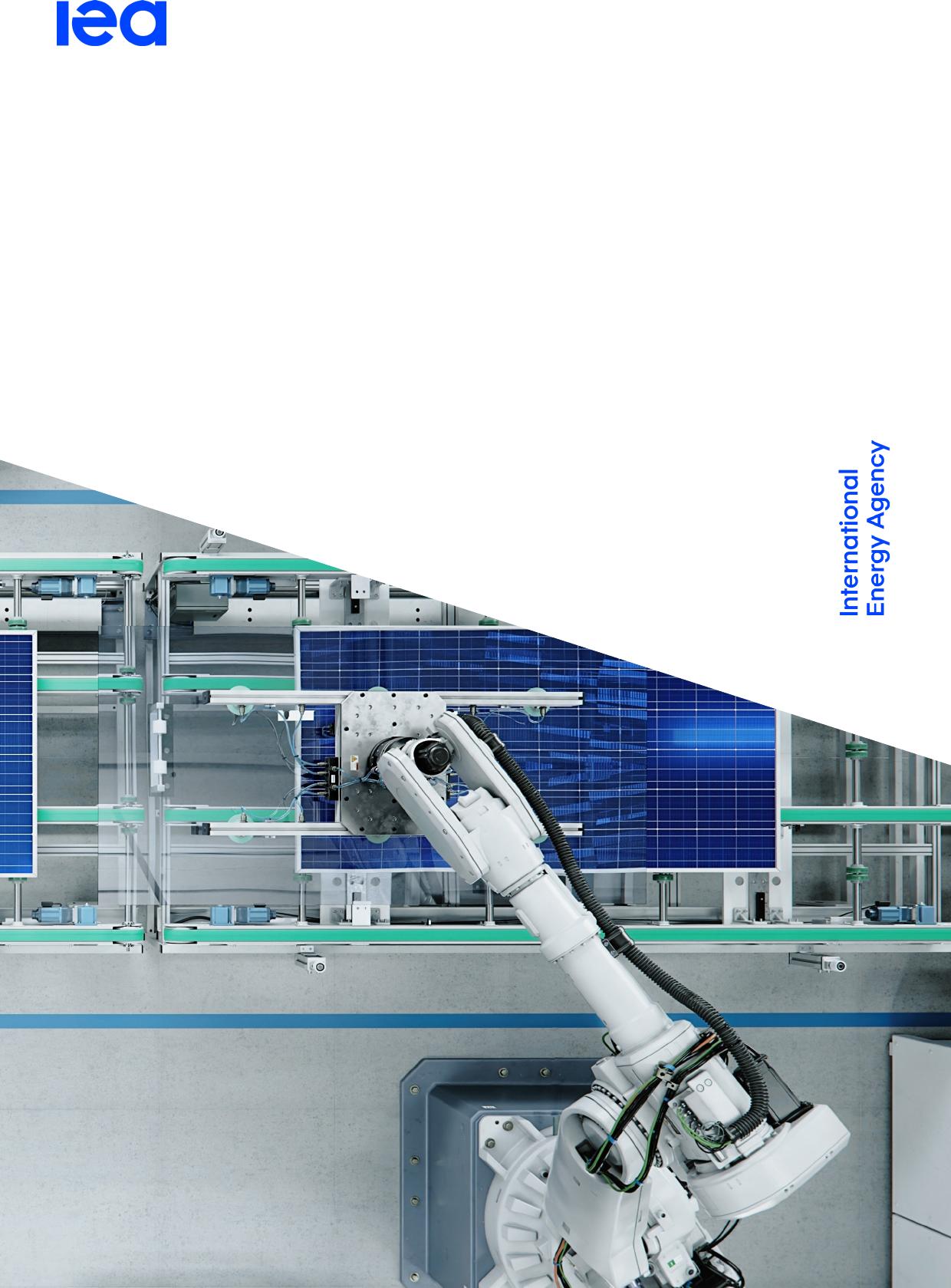TheStateofCleanTechnologyManufacturingAnEnergyTechnologyPerspectivesSpecialBriefing–November2023UpdateINTERNATIONALENERGYAGENCYTheIEAexaminestheIEAmemberIEAassociationfullspectrumcountries:countries:ofenergyissuesincludingoil,gasandAustraliaArgentinacoalsupplyandAustriaBrazildemand,renewableBelgiumChinaenergytechnologies,CanadaEgyptelectricitymarkets,CzechRepublicIndiaenergyefficiency,DenmarkIndonesiaaccesstoenergy,EstoniaKenyademandsideFinlandMoroccomanagementandFranceSenegalmuchmore.ThroughGermanySingaporeitswork,theIEAGreeceSouthAfricaadvocatespoliciesthatHungaryThailandwillenhancetheIrelandUkrainereliability,affordabilityItalyandsustainabilityofJapanenergyinitsKorea31membercountries,Lithuania13associationLuxembourgcountriesandbeyond.MexicoNetherlandsThispublicationandanyNewZealandmapincludedhereinareNorwaywithoutprejudicetothePolandstatusoforsovereigntyoverPortugalanyterritory,totheSlovakRepublicdelimitationofinternationalSpainfrontiersandboundariesandSwedentothenameofanyterritory,Switzerlandcityorarea.RepublicofTürkiyeUnitedKingdomUnitedStatesTheEuropeanCommissionalsoparticipatesintheworkoftheIEASource:IEA.InternationalEnergyAgencyWebsite:www.iea.orgTheStateofCleanTechnologyManufacturingAcknowledgementsAnEnergyTechnologyPerspectivesSpecialBriefing–November2023UpdateAcknowledgementsThisstudywaspreparedbytheEnergyTechnologyPolicy(ETP)DivisionoftheDirectorateofSustainability,TechnologyandOutlooks(STO)oftheInternationalEnergyAgency(IEA).ThestudywasdesignedanddirectedbyTimurGül,ChiefEnergyTechnologyOfficerandHeadoftheEnergyTechnologyPolicyDivision.Theanalysisandproductionwasco-ordinatedbyAraceliFernandezPales,HeadoftheTechnologyInnovationUnitandPeterLevi.Theleadauthorswere(inalphabeticalorder)JoséBermudezMenendez(electrolysers),ChiaraDelmastro(heatpumps),MathildeHuismans(wind),TeoLombardo(batteries),RafaelMartinezGordon(heatpumps),FaidonPapadimoulis(solarPVanddatamanagement)andFrancescoPavan(electrolysers).Per-AndersWidellprovidedessentialsupportthroughouttheprocess.LizzieSayereditedthemanuscript.ThanksalsototheIEACommunicationsandDigitalOfficefortheirhelp,particularlytoJethroMullen,AstridDumond,ClaraVallois,PoeliBojorquez,AyaShaqra.ValuablecommentsandfeedbackwereprovidedbyothercolleagueswithintheIEA,inparticularLauraCozzi,PiotrBojekandDennisHesseling.PAGE3IEA.CCBY4.0.TheStateofCleanTechnologyManufacturingTableofcontentsAnEnergyTechnologyPerspectivesSpecialBriefing–November2023UpdateTableofcontentsKeyfindings.................................................................................................................5PartI:Introduction......................................................................................................7PartII:Analysis...........................................................................................................9Asnapshotofthelatestdevelopments......................................................................................9Regionalconcentration............................................................................................................21PartIII:Recentpolicydevelopments.......................................................................32UnitedStates............................................................................................................................32EuropeanUnion.......................................................................................................................33Othereconomies......................................................................................................................34PAGE4IEA.CCBY4.0.TheStateofCleanTechnologyManufacturingKeyfindingsAnEnergyTechnologyPerspectivesSpecialBriefing–November2023UpdateKeyfindings•CleanenergytechnologiesareforegroundedintheIEA’supdatedNetZeroEmissionsby2050Scenario(NZEScenario),whichhighlightsimpressivegrowthinsolarPVinstallationsandelectricvehiclesasoneofthesuccessstoriesofrecentyearshelpingtokeepthenetzerogoalwithinreach.•Noneoftheseadvanceswouldhavebeenpossiblewithoutgrowthincleanenergytechnologymanufacturing,andmanufacturingnowneedstoacceleratefurtherinordertomeettargetsfor2030deploymentconsistentwiththenetzerogoal.•ThisEnergyTechnologyPerspectivesSpecialBriefingprovidesasnapshotofthelatestdevelopmentsinmanufacturingcapacityacrossfivekeytechnologies:solarPV,windenergy,heatpumps,electrolysersandbatteries.•Announcementsduringjustthemiddletwo-quartersof2023–theanalysisperiodsinceourlastSpecialBriefinginMay–accountfornearly40%ofthetotalannouncedcapacityforsolarPV,10%forbatteriesand20%forelectrolysers.However,thegrowthinannouncedcapacityhasbeenslowing.Globally,theaveragemonthlyrateofadditionstotheprojectpipelineduringQ2-Q32023hashalvedrelativetotheperiodexaminedintheMaySpecialBriefingforsolarPV,reducingbynearlytwo-thirdsforbatteries,andbynearlyone-thirdforelectrolysers.•Forthefirsttime,announcedprojectsforelectrolysermanufacturingcouldmeetdeploymentneedsfortheNZEScenarioin2030.Almost170GWofinstalledmanufacturingcapacitycouldbeexpectedby2030,ifallannouncedprojectsarerealised.However,lessthan10%ofannouncedprojectsforelectrolysersarecommitted–i.e.theyhavereachedafinalinvestmentdecision(FID)orareunderconstruction.Meetingdeploymentneedsfornetzerowillrequirealloftheseprojectstomoverapidlytowardscompletion,backedbysustainedandstronggrowthindemandforelectrolysers,aswellasastep-upinoperationsforalreadyinstalledcapacity.•SolarPVmanufacturingcontinuestosurgeahead,withprojectedthroughputofexistingandannouncedprojectsnowtwo-thirdshigherthanthelevelrequiredtosatisfydeploymentneedsin2030intheNZEScenario.•Forbatteries,thelatestannouncementscontinuetoaddtothehugeincreaseinmanufacturingcapacityembodiedbyprojectannouncementsoverthepastyear.Ifallannouncedprojectsarerealised,totalmanufacturingcapacityby2030wouldreach7500GWh,almostfive-timescurrentinstalledcapacity,whichreached1550GWhperyearattheendof2022.Atthegloballevel,announcedbatterymanufacturingcapacitywouldbesufficienttomeetdeploymentneedsforbothmobilityandstationaryapplicationsintheNZEScenarioin2030.•Heatpumpmanufacturingcapacityadditionstendtobelessprominentlyannouncedthanthoseforothertechnologies,butannouncementshavesloweddowncomparedto2022inthefaceofuncertaintyaboutdemand.Insomecountries,thisresultsfromthePAGE5IEA.CCBY4.0.TheStateofCleanTechnologyManufacturingKeyfindingsAnEnergyTechnologyPerspectivesSpecialBriefing–November2023Updatedowngradingofsubsidyschemes,or–conversely–fromconsumerspostponinginvestmentdecisionsinanticipationofforthcomingincentives.Thedownwardtrendcouldthereforebereversedinthenearterm.•Therehasbeenverylimitedactivityintheprojectpipelineforwindenergy,andcapacityremainssignificantlybelowthedeploymentlevelsrequiredintheNZEScenario.Newlyannouncedfacilitiesformanufacturingonshorewindcomponentsonlyjustoutweighedothersthatwerecancelled.•Thesuccessfulcompletionofmanufacturingcapacityadditionsforoffshorewindenergyprojectsdependsonthefinancialstabilityoforiginalequipmentmanufacturers,whichisitselfstronglyaffectedbythetenderingandcontractingprocessfornewsites.Anydelaysorcancellationscanthereforehaveadirecteffectonmanufacturingfacilities.•Thereisastrongdegreeofregionalconcentrationinmanufacturingforallfivetechnologiesconsideredhere,andonthebasisofprojectannouncements,thesamecountriesandregionswillcontinuetodominatemanufacturingthroughto2030.Therelativesharesofthedifferentcountriesandregionsincapacityforeachtechnologywillneverthelessundergoasmallshift.•Chinaisexpectedtocontinuetoaccountforthemajorityofmanufacturingcapacityforwind,batteries,andespeciallysolarPV,aswellasfortheirkeycomponents.Announcedprojectssuggestthatthemanufacturingbaseforheatpumpsandelectrolyserswillbroadenoutslightly,withnocountryorregionaccountingformorethan50%ofcapacity.•Ensuringthatcleanenergytechnologysupplychainsaresecureandresilientareanimportantaimofpublicpolicy.Majorpolicyannouncementsofrecentyears,includingtheUSInflationReductionAct,theEUNetZeroIndustryActandIndia’sProductionLinkedIncentiveschemearealreadystartingtoripplethroughthemanufacturingsector.•Forsometechnologies–notablyelectrolysersintheUnitedStatesandheatpumpsinseveralEuropeancountries–ongoingpolicychangeshaveresultedinuncertaintyanddelayswithregardstodemand.Toincreaseconfidenceinthereliabilityoffuturedemand,itisessentialtoensurethatdelaysinpolicyimplementationareminimised.PAGE6IEA.CCBY4.0.TheStateofCleanTechnologyManufacturingPartI:IntroductionAnEnergyTechnologyPerspectivesSpecialBriefing–November2023UpdatePartI:IntroductionCleanenergytechnologiesarecentraltoeffortstomeettheworld’sclimate,energysecurityandeconomicdevelopmentgoals.Increasingdeploymentatthepaceneededtogetontrackfornetzeroemissionsby2050willrequirearapidstep-upinmanufacturingcapacityforcleantechnologies.ThisEnergyTechnologyPerspectives(ETP)SpecialBriefingprovidesatargetedupdateonrecentprogressincleanenergytechnologymanufacturinginkeyregions.Coveringfivetechnologies–solarPVmodules,1windturbines,2batteries,3electrolysers4andheatpumps5–thatwillbecriticaltotheenergytransition,theanalysisisfocusedontheareasofsupplychainsthatareshowingthegreatestdynamisminresponsetorecentpolicyandindustrialstrategydevelopments.ItcontainsdataontheprojectpipelineforkeytechnologiestotheendofSeptember2023,andtakesintoaccountthelatestupdatestotheIEA’sNetZeroEmissionsby2050Scenario(NZEScenario),publishedinSeptember2023,toexamineprogresstowardsclimategoals(seeBox1foradescriptionofthescenariosusedinthisSpecialBriefing).6ThisanalysisconstitutesoneofthedeliverablesrequestedbyG7leadersfromtheIEA:anupdateoncleantechnologysupplychainstobeprovidedaheadofCOP28,thenextUNClimateChangeConferenceoftheParties,attheendof2023.ItfollowsasimilarETPSpecialBriefingpublishedinMay2023tosupportthedeliberationsattheHiroshimaSummit.ThesepublicationsbuildonanalysisconductedaspartofthelatesteditionoftheIEA’stechnologyflagshippublication,EnergyTechnologyPerspectives2023(ETP-2023),publishedinJanuary2023.ThisreportalsoformspartoftheIEA’ssupportofthefirstglobalstocktakeoftheParisAgreement,whichwillbefinalisedintherun-uptoCOP28.FindotherreportsinthisseriesontheIEA’sGlobalEnergyTransitionsStocktakepage.1Hereafter“solarPV”,unlessaparticularcomponentorintermediatestepinproductionisspecified.IEA.CCBY4.0.2Hereafter“wind”,withanalysisbasedonaggregateoraveragequantitiesfornacelles,towersandbladesasappropriate.3Includingbothmobileandstationaryapplicationsandallbatterychemistries.4Includingalkaline,protonexchangemembrane,anionmembraneexchangeandsolidoxidetechnologies.5Forbuildingsapplicationsonly.6TheupdatedNetZeroRoadmaphighlightsthegrowingroleofelectrificationonthepathtonetzeroemissionsandcostreductionsthathaveboostedtake-upoftechnologiessuchassolarPVandbatteries.The2023NZEScenariothereforereflectsthesechangeswithupdateddeploymentratesforkeytechnologies.Forexample,solarPVandElectricVehicles(EVs)takeamoreprominentrole,whereasforwindandhydrogen,thedeploymentratehasbeenreviseddownwards,basedonrecentinvestmenttrendsfrommanufacturerscomparedtootherlow-emissionsalternatives.PAGE7TheStateofCleanTechnologyManufacturingPartI:IntroductionAnEnergyTechnologyPerspectivesSpecialBriefing–November2023UpdateBox1ScenariosusedinthisSpecialBriefingAnalysisinthisSpecialBriefingisunderpinnedbyglobalprojectionsofcleanenergytechnologiesderivedfromtheIEA’sGlobalEnergyandClimate(GEC)model,adetailedbottom-upmodellingframeworkcomposedofseveralinterlinkedmodelscoveringenergysupplyandtransformation,andenergyuseinthebuildings,industryandtransportsectors.Themodellingframeworkincludes29regionsorcountriescoveringthewholeworld.ThemostrecentyearofcompletehistoricaldatafromtheGECmodelis2022,towhichyear-end2022manufacturinginstalledcapacitydatahavebeenaddedaspartoftheanalysisforthisSpecialBriefing.DataforQ32023areavailableforsometechnologies.Forprojectedvaluesto2030,wemakeuseoftwoIEAscenariosproducedusingtheGECmodelthatdescribepossibleenergysystempathways:TheNetZeroEmissionsby2050Scenario(NZEScenario)isanormativescenariothatsetsoutapathwaytostabiliseglobalaveragetemperaturesat1.5°Cabovepre-industriallevels.TheNZEScenarioachievesglobalnetzeroenergysectorCO2emissionsby2050withoutrelyingonemissionsreductionsfromoutsidetheenergysector.Indoingso,advancedeconomiesreachnetzeroemissionsbeforedevelopingeconomiesdo.TheNZEScenarioalsomeetsthekeyenergy-relatedUNSustainableDevelopmentGoals,achievinguniversalaccesstoenergyby2030andsecuringmajorimprovementsinairquality.TheAnnouncedPledgesScenario(APS)assumesthatgovernmentswillmeet,infullandontime,alltheclimate-relatedcommitmentstheyhaveannounced,includinglonger-termnetzeroemissionstargetsandNationallyDeterminedContributions(NDCs),aswellascommitmentsinrelatedareassuchasenergyaccess.Itdoessoirrespectiveofwhetherthesecommitmentsareunderpinnedbyspecificpoliciestosecuretheirimplementation.Pledgesmadeininternationalforaandinitiativesonthepartofbusinessesandothernon-governmentalorganisationsarealsotakenintoaccountwherevertheyaddtotheambitionofgovernments.Neitherscenarioshouldbeconsideredapredictionorforecast.Rather,theyareintendedtoofferinsightsintotheimpactsandtrade-offsofdifferenttechnologychoicesandpolicytargets,andtoprovideaquantitativeframeworktosupportdecision-makingintheenergysector,andstrategicguidanceontechnologychoicesforgovernmentsandotherstakeholders.ThescenariosandresultsareconsistentwiththosepresentedintheWorldEnergyOutlook2023.PAGE8IEA.CCBY4.0.TheStateofCleanTechnologyManufacturingPartII:AnalysisAnEnergyTechnologyPerspectivesSpecialBriefing–November2023UpdatePartII:AnalysisAsnapshotofthelatestdevelopmentsTheupdatedprojectpipelinetotheendofSeptember2023(end-Q32023)showsthatthenumberofannouncedprojectsformanufacturingcleantechnologieshascontinuedtorise,albeitatamoremoderatepace.Theannouncementsduringjustthemiddletwo-quartersof2023(Q2-Q32023)–theanalysisperiodsinceourlastSpecialBriefinginMay–accountfornearly40%ofthetotalannouncedcapacityforsolarPV,10%forbatteriesand20%forelectrolysers.However,thegrowthinannouncedcapacityhasbeenslowing.Globally,theaveragemonthlyrateofadditionstotheprojectpipelineduringQ2-Q32023hashalvedrelativetotheperiodexaminedintheMaySpecialBriefingforsolarPV,reducingbynearlytwo-thirdsforbatteries,andbynearlyone-thirdforelectrolysers.Figure1ProjectedthroughputfromexistingandannouncedmanufacturingcapacityrelativetoNetZeroEmissionsby2050Scenariodeploymentneedsin2030150%2030NZEScenariodeployment100%50%SolarPVBatteriesWindHeatpumpsElectrolysersExistingmanufacturingcapacity:Announcedmanufacturingprojects:Additionaltoend-Q32023Additionaltoend-Q12023Increasedutilisation2022productionAsoflate2022IEA.CCBY4.0.Note:NZEScenario=NetZeroEmissionsby2050Scenario.2022productionvaluesreflectestimatesofactualutilisationrates.Increasedutilisationreferstothegapbetween2022productionlevelsandexistingcapacitybeingutilisedat85%.Autilisationrateof85%isusedforbothexistingandannouncedmanufacturingcapacityin2030.Source:IEAanalysisbasedondatafromInfoLink,BNEF,WoodMac,EVVolumes,BMI,UNComtradeandannouncementsbymanufacturersandpersonalcommunications.PAGE9IEA.CCBY4.0.TheStateofCleanTechnologyManufacturingPartII:AnalysisAnEnergyTechnologyPerspectivesSpecialBriefing–November2023UpdateIfallannouncedprojectsgoahead,manufacturingforsolarPV,batteriesandelectrolyserswillbeabletoaccommodatedeploymentneedsconsistentwiththelatestupdatetotheNZEScenarioby2030.Thisisdespitethefactthatinthislatestscenarioupdate,2030solarPVandbatterydeploymentishigherthanitwasinthepreviouseditionoftheNZEScenariousedforthecomparisonintheMayeditionofthisSpecialBriefing.Forthefirsttime,announcedprojectscomprisesufficientcapacityfor2030electrolyserdeploymentneedsaswell,inpartduetolowerlevelsofdeploymentintheupdatedNZEScenario,relativetothepreviousedition.Inaddition,forsolarPV,batteriesandelectrolysers,theutilisationratesofexistingmanufacturingcapacitiesarelow,indicatingthattheremaybeovercapacityatpresent–butalsothatproductioncouldquicklyrampup.Incontrast,thewindmanufacturingindustryhasseennegligiblechangestotheprojectpipelineinthepast6months,withnewlyannouncedfacilitiesforonshorewindcomponentsonlyjustoutweighingotherprojectsthatwerecancelled.Announcementsformanufacturingofheatpumpshaveslowedinthefaceofuncertaintyaboutfuturepolicysupportandthusconsumerdemand.TherelativelyshortleadtimesrequiredtobringnewmanufacturingcapacityforwindandheatpumpsonlinemeanthatbridgingthegaptoNZEScenariolevelsby2030ispossible,butwillrequirededicatedpolicysupport.Thereisasignificantsplitbetweenannouncedprojectsthatarecommitted–i.e.theyhavereachedanFIDorareunderconstruction–andthosethatremainatapreliminarystageintheirdevelopment.Forexample,lessthan15%ofannouncedprojectsforelectrolysersarecommitted.Thisrequiressustainedattentiontoensurethatannouncedprojectsmaterialise.Box2CategorisationofmanufacturingdataInthisSpecialBriefingthemanufacturingdataforthefocusfivecleanenergytechnologiescanbecategorisedasfollows:“Installedmanufacturingcapacity”referstothemaximumratedoutputoffacilitiesforproducingagiventechnology.Capacityisstatedonanannualbasisforthefinalproductanddoesnotrefertothecapacityforanyintermediateproductsorcomponents.Whereavailable,manufacturingcapacityforkeycomponentsisprovidedseparately.Annualmanufacturing“throughput”isafractionoftheinstalledmanufacturingcapacity.Throughputdependsontheutilisationrateofproductioncapacity,forwhich85%isatypicalannualaveragetargetlevelundernormaloperation.However,utilisationratesforcleantechnologymanufacturingfacilitiestendtobemuchloweronaveragetoday,reflectingsignificantdegreesofovercapacityglobally.2022,thebaseyearfortheanalysisinthisSpecialBriefing,isthemostrecentyearforwhichinstalledmanufacturingcapacitydatahasbeencollected.PAGE10IEA.CCBY4.0.TheStateofCleanTechnologyManufacturingPartII:AnalysisAnEnergyTechnologyPerspectivesSpecialBriefing–November2023Update“Announcedprojects”referstotheaggregatestatedcapacity–orestimatedthroughputofthatcapacity(assumingadefaultutilisationrateof85%)–ofpotentialmanufacturingfacilitiesthathavebeenannounced.Thisincludesprojectsforbuildingnewfacilitiesorexpandingexistingonesthatareatdifferentstagesofdevelopment.‘Committed’projectsincludesprojectsthathavealreadyreachedanFID,orareunderconstruction,whereas‘preliminary’projectsincludethosethathavenotyetreachedanFID.Whereverdataisavailable,werefertothesemilestonesinprojectdevelopment.Unlessotherwisestated,theannouncedprojectsdatasetassembledforthisSpecialBriefingcomprisesannouncementsdateduptoandincludingtheendofthethirdquarterof2023.ExternaldataprovidersincludeInfoLink,ThomsonReuters,BloombergNewEnergyFinance,WoodMackenzie,EVVolumes,andBenchmarkMineralIntelligence.AnnouncedmanufacturingcapacityforsolarPVdoublesagainin2023AnnouncementsforsolarPVmodulemanufacturingprojectscontinuetosurgeahead,withtheadditionalmanufacturingcapacityannouncedhavingapproximatelydoubledsincelate2022.Over380GWofcapacityhavebeenannouncedinthepastsixmonthsalone,whichwouldbesufficienttoaccommodatetheentire2022moduleproduction,bringingthetotalthroughputfromannouncedandinstalledcapacitytoaround1650GWby2030.Thevastmajorityofnewprojectsannounced,i.e.around85%,arebasedinChina,whichisalsoseeingthefastestrateofinstallationsglobally,withalmosthalfoftotalglobalcapacityadditionsin2022(i.e.45%)takingplaceinChina.ThesameaccelerationisalsoobservedintheupstreampartsofthePVsupplychain,withmanufacturingcapacityannouncementsforsolarcellsincreasingbyaround210GWandforwafersbyaround260GW.AnnouncedadditionstopolysiliconcapacityweresmalleroverQ2-Q32023thaninQ12023,butstilltotalledjustunder100GW.SolarPVinstallationsgrewtoreach220GWin2022,withtherateofcapacityadditionsincreasingby35%overthepreviousyear.China’sshareoftheglobaltotalgrewfrom39%in2021to45%in2022–reaching100GW–withChina’sshareexpectedtoincreasefurtherin2023.DespitetheutilisationratesofsolarPVmanufacturingfacilitiesbeingrelativelylowonaverageglobally(around60%),recentexcesssupplyinChinaislikelytohavecreatedalargebacklogofmodulesinEurope(estimatedat60-70GW),accordingtoChineseexportsandglobalinstallationsdata.PAGE11IEA.CCBY4.0.TheStateofCleanTechnologyManufacturingPartII:AnalysisAnEnergyTechnologyPerspectivesSpecialBriefing–November2023UpdateFigure2GWCurrentandprojectedthroughputforsolarPVmanufacturingcapacityanddeploymentintheAnnouncedPledgesScenario12001208002030APSdomesticdeployment80Announcedmanufacturingcapacity:PreliminaryCommitted40040Existingmanufacturingcapacity:Increasedutilisation2022productionChina0EuropeanUnionIndiaUnitedStatesIEA.CCBY4.0.Note:APS=AnnouncedPledgesScenario.2022productionvaluesreflectestimatesofactualutilisationrates.Increasedutilisationreferstothegapbetween2022productionlevelsandexistingcapacitybeingutilisedat85%.Autilisationrateof85%isusedforbothexistingandannouncedmanufacturingcapacityin2030.Source:IEAanalysisbasedondatafromInfoLinkandBNEF.Theprojectedthroughputoftheexistingandannouncedprojectsisnowtwo-thirdshigherthanthelevelrequiredtosatisfydeploymentneedsin2030undertheNZEScenario.ActivityonannouncementsformodulesmanufacturingisalsovisibleoutsideChina,particularlyintheUnitedStatesandIndia,butrespectivecapacityforupstreamcomponentssuchaswafersandpolysiliconisstilllaggingbehindinthesetworegions.Overall,solarPVmodulemanufacturingisthecleantechnologymanufacturingactivitywiththemostsurpluscapacitycomparedtotheglobalNZEScenarioneeds.Itispossiblethatthiswillleadtogreatermarketconsolidationoverthecomingyears,withtheleastcompetitivefacilitiesceasingoperationsandthemostspeculativeannouncementsfailingtomaterialise.IndicativeofthemomentuminsolarPVmanufacturingisthefactthattherearecurrentlyfiveannouncementsforfacilitiesthatareeachcapableofproducing30GWormoreofmodulesperyear,whichwasthesizeofthelargestfacilityidentifiedinourSpecialBriefingpublishedinMaythisyear.Thishasnowbeensurpassedwitha56GWcapacityadditionannouncedbyJinkoSolar.PAGE12IEA.CCBY4.0.TheStateofCleanTechnologyManufacturingPartII:AnalysisAnEnergyTechnologyPerspectivesSpecialBriefing–November2023UpdateTable1MajorsolarPVmanufacturingfacilitiesoperatingornearcompletionCompanyLocationCountryProductionProjectedcompletionProjectedyearatcapacityyearmaximumJinkoSolarShanxiChina56GW2024202540GW20242026JinkoSolarZhejiangChina35GW2023202430GWOperating2025GCLJiangsuChina30GW20232026GCLAnhuiChinaSOLAR-GRIDSZhejiangChinaSource:IEAanalysisbasedondatafromInfoLink.WindmanufacturingbesetbydelaysandcancellationsdespiterecordinstallationsNewlygrid-connectedwindcapacityin2023isexpectedtoreboundtotherecordlevelsof2020,reversingthetrendofdecreasinginstallationsduring2021-2022.Theratioofonshoretooffshoreinstalledcapacityremainsbroadlyconstantatapproximately6:1.Despitethisprojectedreturntogrowth,therehasbeenverylimitedactivityintheprojectpipelineforfacilitiesmanufacturingwindenergycomponents,withcapacityremainingsignificantlybelowNZEScenariodeploymentlevels.Sincethebeginningof2023therehasbeenasmallincreaseintheshareofoffshorewindfacilitiesthatcanbeconsideredcommitted,butforonshorewindcomponents,newlyannouncedcapacityonlyjustoffsetthequantitythatwascancelled.Figure3CurrentandprojectedthroughputforwindmanufacturingcapacityanddeploymentintheAnnouncedPledgesScenario80GWIEA.CCBY4.0.2030APSdomesticdeployment60Announcedmanufacturingcapacity:Preliminary40CommittedExistingmanufacturing20capacity:2022productionChinaNorthAmericaEuropeanUnionRoWIEA.CCBY4.0.Notes:APS=AnnouncedPledgesScenario;RoW=RestofWorld.Manufacturingcapacityiscalculatedasanaverageofnacelle,towerandbladecapacity.2022productionvaluesreflectestimatesofactualutilisationrates.Autilisationrateof85%isusedforbothexistingandannouncedmanufacturingcapacityin2030.Source:IEAanalysisbasedondatafromWoodMackenzie.PAGE13TheStateofCleanTechnologyManufacturingPartII:AnalysisAnEnergyTechnologyPerspectivesSpecialBriefing–November2023UpdateAlmostalloffshorewindmanufacturingcapacityformerlyassessedaspreliminaryandnowconsideredcommittedislocatedinChina.Thecountrywasalsoresponsibleforhalfofglobalannualcapacityadditionsin2022.FurtherprojectshavemovedfrompreliminarytocommittedstatusinNorthAmerica,whileotherannouncedinvestmentsthisyearhavebeenrevised.AnumberofoffshoreprojectswerehaltedinEurope,castingdoubtonthelikelihoodofseveralotherprojectannouncementsmaterialising.Thelimitedactivityinmanufacturingprojectannouncementsispartlyduetounder-utilisationofexistingcapacityandthefactthatfinalinvestmentdecisionsareonlytakenaftertendersareawarded,whichhasrepercussionsthroughoutthesupplychain.Furthermore,slowandcomplexpermittingforbothonshoreandoffshorewindprojectsisdelayingfutureinvestmentdecisionsbymanufacturers.In2022around80GWofwindinstallationprojectsinEuropewerestuckinpermittingprocedures.Severaloffshorewindprojectshavebeendelayedorcancelledsincethebeginningof2023,includingtheNorfolkBoreasprojectoffthecoastoftheUnitedKingdom,andOceanWind1and2intheUnitedStates.Developershavelinkedcancellationstorisingcostsduetoinflationandhighcommodityprices,aswellassupplychainbottlenecks.Somemanufacturershavealsohadproblemswithcomponentsofwindturbines,notablySiemensEnergy,whichreportedalossofEUR2.9billioninitsQ3earningsrelease,partlyduetotechnicalproblemswithrotorbladesforitsonshoreturbines,togetherwithrisingcosts.AshortageofsuitableinstallationvesselsrecentlyledtoaprojectinChinaTaipeibeinghalted,andalackofvesselsisloomingasapotentialfuturebarriertothescale-upofinstallationsinlinewithcountries’climateambitions.Thisissueisfurtherexacerbatedbytheincreasingsizeofwindturbinesinrecentyears,requiringeverbiggervesselsandassociatedadaptationsatports.Offshorewindturbinerotordiametershavegrownfromaround120to200metressince2010(comparedtoforonshoreturbines),posingchallengesforturbinemanufacturerswhohavetoinvestinupgradestoequipmentandtestingfacilitiesandundergonewcertificationproceduresinordertobringnewdesignstomarketandretainacompetitiveedge.Thedisruptionstoinstallationprojectsthatstemfromthesecomplicationscanhavedirectrepercussionsformanufacturingfacilities.PAGE14IEA.CCBY4.0.TheStateofCleanTechnologyManufacturingPartII:AnalysisAnEnergyTechnologyPerspectivesSpecialBriefing–November2023UpdateBox3HowtheoffshoretenderdesignandcontractawardprocesscanimpactmanufacturingcapacityforwindenergyThesuccessfulcompletionofmanufacturingcapacityadditionsforwindenergyprojectsisdependentonthefinancialstabilityoforiginalequipmentmanufacturers(OEMs),whichisdeeplyintertwinedwiththedesignoftenders.Manufacturingcapacityforwindishardtomeasure,asfacilitiesannouncementsandfinalinvestmentdecisionsaremadeonlyafterasiteisawardedbygovernments,meaningthatanyprojectcancellationsordelayshaveadirectknock-oneffectonmanufacturingfacilitiesandthefinancialstabilityofOEMs.Inlightofthis,delaysandcancellationsmayalsoendangerfutureinvestmentsintomanufacturing,orintonewsites.Thiscanresultinunder-investmentacrossthesupplychainandreductionsinoverallglobalmanufacturingcapacity.Thedesignoftendersforwindneedstobecarefullyconsideredtoensurethattheyreceivestrongproposals,andthatwinningprojectshavethebestpossiblechanceofbeingrealisedontimeandonbudget.Inmanyinstances,auctionsforwindarebasedlargelyonprice,whichcanleadtonegativebiddingandaracetothebottom.Whenthecontractpricesonofferareconsideredtoorisky,theresultcanbeauctionsnotreceivinganybids,aswasthecasefortheUnitedKingdom’slatestoffshorewindauction.Inthecontextofrisingcostsforwinddevelopers,actiontoindexpricescanensurethatfutureinflationhaslessofanimpactonprofitability.Whereavailable,environmentalassessmentsandsitesurveyscarriedoutpriortotheannouncementoftenderscanalsohelppotentialbidderstoaccuratelyassesslikelyinvestmentneeds.BatterymanufacturingcontinuestoexpandBatterymanufacturingprojectannouncementshavecontinuedthroughoutthefirstthreequartersof2023,backedbystronguptakeofelectricvehicles(EVs)supportedbypolicyincentivesinseveralmajorregions.LookingatthepipelineofannouncedmanufacturingprojectsduringQ1-Q32023,1160GWhofcapacityhasbeenadded,with730GWhaddedinthelattertwoquartersalone.Thisgrowthneverthelessconstitutesadecelerationrelativetothesameperiodin2022(equaltoapproximately60%ofthegrowthinQ2-Q32022),suggestingthatmanufacturersarenowshiftingtheirfocustosecuringfundingandbuildingorexpandingpreviouslyannouncedplantsratherthanplanningnewinstallations.Ifallannouncedprojectsarerealised,totalmanufacturingcapacityby2030wouldreach7500GWh,almostfive-timescurrentlyinstalledcapacity,whichreached1550GWhattheendof2022.PAGE15IEA.CCBY4.0.TheStateofCleanTechnologyManufacturingPartII:AnalysisAnEnergyTechnologyPerspectivesSpecialBriefing–November2023UpdateFigure4GWhCurrentandprojectedthroughputforbatterymanufacturingcapacityanddeploymentintheAnnouncedPledgesScenario45002030APSdomestic3000deploymentAnnouncedmanufacturingcapacity:PreliminaryCommitted1500Existingmanufacturingcapacity:Increasedutilisation2022productionChinaUnitedStatesEuropeanUnionIndiaIEA.CCBY4.0.Notes:APS=AnnouncedPledgesScenario.2022productionvaluesreflectestimatesofactualutilisationrates.Increasedutilisationreferstothegapbetween2022productionlevelsandexistingcapacitybeingutilisedat85%.Autilisationrateof85%isusedforbothexistingandannouncedmanufacturingcapacityin2030.Forbatterymanufacturingspecifically,‘committed’referstoprojectsthatarecurrentlyunderconstructionorexpansionsofcurrentplants,withallotherannouncementsbeingcategorisedas‘preliminary’.Source:IEAanalysisbasedondatafromBMI,BNEFandEVVolumes.Globalbatterymanufacturingcapacityannouncements,ifcompletedinfullandontime,wouldbesufficienttomeetdeploymentneedsintheNZEScenarioin2030.However,lessthanhalfthecapacityembodiedbytheseannouncedprojectsisunderconstruction,includingexpansionsofexistingmanufacturingfacilities.Bringingbatterymanufacturingfacilitiesonlinerequiressignificantinvestmentandaccesstoaskilledworkforce,withoutwhichannouncedprojectsmightbedelayedorfail.Thisisespeciallytrueinregionsthattodayhavelimitedexperienceinbatterymanufacturingatscale.Thecollapsein2023ofUKbatterymanufacturerBritishvolt,whoseplansforagigafactoryinthenorth-eastofEnglandfailedtosecureinvestment,illustratesthechallengeofestablishingnewmanufacturingfacilities.Inaddition,theglobalaverageutilisationofbatterymanufacturingcapacityisestimatedataround35%,assumingnostockpiling.Thisindicatessignificantsurpluscapacitycomparedtocurrentdemand,butalsosuggestsmanufacturersarepreparedtorespondtothewidelyexpectedincreaseindemandinthecomingyears.TheprojectedthroughputfromexistingandannouncedbatterymanufacturingcapacityinChinain2030isexpectedtobethreetimesthecountry’sdomesticPAGE16IEA.CCBY4.0.TheStateofCleanTechnologyManufacturingPartII:AnalysisAnEnergyTechnologyPerspectivesSpecialBriefing–November2023UpdatedemandintheAnnouncedPledgesScenario(APS).7Ifannouncedprojectsallmaterialise,productioninEuropeissettobesufficienttosatisfydomesticdemandunderthesamescenario,andproductionintheUnitedStateswillalmostmeetdomesticdemand.Domesticbatteryproductionofotherimportantregions,notablyIndia,issettobeinsufficienttocoveritsAPSdeploymentneedsby2030.Box4EvenmorebatteriesonthehorizonToday,thereareanumberofearly-stagebatterymanufacturingcompaniesinChina,EuropeandtheUnitedStatesthatareeitherbuildingtheirfirstplantsoralreadyservingnon-EVrelatedmarkets,includingthoseforstationaryandportablebatteries.Theultimategoalofmanyofthesecompaniesistobuilduptheexpertise,fundingandmachinery,aswellasthecertificationsrequired,toeventuallyservetheEVmarket.Iftheseearly-stagemanufacturers–someofwhicharebackedbyimportantautomakerssuchasVolkswagen,RenaultandStellantis–aresuccessfulinmeetingthisaim,batterymanufacturingcapacitycouldbeevenhigherthandescribedabove.Preliminary,committedandearly-stagebatterymanufacturingcapacityacrossalllithium-ionbatterymarkets,2022-20309000GWh6000NotcurrentlycertifiedIEA.CCBY4.0.3000CertifiedforEVmarket0202520302022IEA.CCBY4.0.Note:CompaniesthatarecertifiedtoproducebatteriesfortheEVmarketcanalsoservethestationarystoragemarket,butnotvice-versa.Source:IEAanalysisbasedondatafromBMI.7Assuminganaverageutilisationfactorof85%.PAGE17TheStateofCleanTechnologyManufacturingPartII:AnalysisAnEnergyTechnologyPerspectivesSpecialBriefing–November2023UpdateAleapinannouncedelectrolysermanufacturingcapacityclosesthegapwithNZEScenariodeploymentAnnouncedmanufacturingcapacityforelectrolyserscontinuestoincrease,backedbystrongpoliticalmomentumaroundlow-emissionshydrogenwhichisboostingexpansionambitionsamongmanufacturers.Ifallannouncedprojectswererealised,almost170GWofmanufacturingcapacitycouldbeinstalledby2030,whichforthefirsttimemeansthatthecurrentprojectpipelineissufficienttomeetthe2030deploymentneedsoftheNZEScenario.Chinaaccountsforthemajorityoftotalcapacityannouncedin2023(23GW),followedbytheUnitedStates(16GW)andEurope(13GW).TheUnitedStateshasseenthebiggestincreaseinannouncementsin2023,morethandoublethoseof2022,boostedbytheeffectoffinancialincentivesforlow-emissionshydrogen.Forexample,inOctober2023,JohnCockerillannouncedtheconstructionofanewmanufacturingsiteinBaytown(Houston)closetooneoftheselectedregionalhydrogenhubsthatwillreceivefundingfromtheUSDepartmentofEnergy.20%ofthecapacityoftheprojectpipeline–30GW–hasbeenannouncedwithnospecifiedlocation,meaningthattheregionaldistributionofannouncementsissubjecttosignificantchangeaspolicyincentivesevolve.Figure5CurrentandprojectedthroughputforelectrolysermanufacturingcapacityanddeploymentintheAnnouncedPledgesScenario50402030APSdomestic30deployment2010Announcedmanufacturingcapacity:PreliminaryCommittedExistingmanufacturingcapacity:Increasedutilisation2022productionGWChinaUnitedStatesEuropeanUnionIndiaIEA.CCBY4.0.IEA.CCBY4.0.Notes:APS=AnnouncedPledgesScenario.2022productionvaluesreflectestimatesofactualutilisationrates.Increasedutilisationreferstothegapbetween2022productionlevelsandexistingcapacitybeingutilisedat85%.Autilisationrateof85%isusedforbothexistingandannouncedmanufacturingcapacityin2030.Whilethisprogressisencouraging,therearethreereasonstobelesssanguine.Firstly,currentutilisationratesareextremelylow,withjustover1GWofelectrolyserproductionfrom13GWofstatedcapacityin2022.WhileitappearsPAGE18TheStateofCleanTechnologyManufacturingPartII:AnalysisAnEnergyTechnologyPerspectivesSpecialBriefing–November2023Updatefeasiblethatproductioncouldscalequicklyifordersweretosurgeasaresultofgenerousincentivesonoffer–notablythoseinNorthAmericaandEurope–accountsfrommanufacturerssuggestthatasignificantfractionofthiscapacityisnotyetfullyoperating,orstillundergoingaphasedramp-up.Secondly,manyoftheannouncedfactoriesareassemblyfacilitiesthatwillrequireasupplyofcomponents(membranes,cathodes,anodes,bi-polarplates,powerelectronics,etc.)toproducetheelectrolyserstacksandthefinalelectrolysersystem.Reachingthecapacityexpansionenvisagedbyannouncedprojectswilldependonthescale-upofmanufacturingcapacityofallthesecomponentsinparallel,topreventbottlenecksoccurringincertainpartsofthesupplychain.Finally,theshareofmanufacturingprojectsinthepipelinethatarefirmlycommittedremainssmall.Onlyaround10%ofcurrentannouncementsincapacitytermshavereachedFID.Thisreflectscontinuinguncertaintyarounddemandforlow-emissionshydrogen,andotherbarrierstoscale-up,suchasincreasingcosts,whicharedelayingequipmentordersthatcouldprovideaclearsignaltomanufacturerstocommittoinvestmentsinannouncedcapacity.However,justthecommittedcapacityinChinaissufficienttofulfildomesticdeploymentneedsoftheAPSin2030,andtheEuropeanUnionisquiteclosetobeinginthesameposition.Announcementsforheatpumpmanufacturinghavesloweddown,reflectinguncertaintyaboutdemandAnnouncementsofmanufacturingprojectsforheatpumpshaveslowedrelativeto2022,withonlyafewannouncementstakingplacesincethebeginningof2023.Manufacturersareuncertainabouttheprospectsforshort-termdemandamidstthescalingbackofinstallationincentivesinkeymarkets,resultinginaslowdowninmanufacturingannouncements.AdditionstotheprojectpipelineduringtheperiodQ2-Q32023werelimitedtosomeannouncementsofsmallamountsofcapacityintheEuropeanUniontotallingaround1GW.8Announcedmanufacturingprojectsforheatpumpscurrentlymeetaround35%ofdeploymentneedsintheNZEScenarioin2030.However,manufacturingcapacityexpansionsforheatpumpstypicallyfollownear-termdemandtrends,meaningadditionscouldrampupquickly.Inaddition,heatpumpstendtobepartofawidermanufacturingportfolio,andarethereforenotasprominentlyannouncedasforothertechnologies,especiallyoutsideofEurope.Theslowdowninmanufacturing8Q42023hasalreadyseentwolargeannouncementsintheEuropeanUnion,withBoschinvestingmorethanaUSD100millioninaheatpumpfactoryinPortugalby2026,andGroupeAtlanticannouncingplansforaninvestmentofmorethanEUR150millioninFrance,aswellasdevelopmentsintheUnitedStates,wheretheDepartmentofEnergyawardedUSD169millionfor9projectstoexpandmanufacturingcapacityforheatpumps,includingcompressorsandlow-carbonrefrigerants.PAGE19IEA.CCBY4.0.TheStateofCleanTechnologyManufacturingPartII:AnalysisAnEnergyTechnologyPerspectivesSpecialBriefing–November2023Update–andthegaptodeploymentlevelsconsistentwiththeNZEScenario–maythereforebelesspronouncedthanitappears.Figure6CurrentandprojectedthroughputforheatpumpmanufacturingcapacityanddeploymentintheAnnouncedPledgesScenario120GW902030APSdomesticdeployment60Announcedmanufacturingcapacity2022production30ChinaUnitedStatesEuropeanUnionJapanIEA.CCBY4.0.Note:APS=AnnouncedPledgesScenario.2022productionvaluesreflectestimatesofactualutilisationrates.Autilisationrateof85%isusedforbothexistingandannouncedmanufacturingcapacityin2030.Source:IEAanalysisbasedondatafromUNComtrade.IntheUnitedStates,eventhoughshipmentsofheatpumpsweredownbyaround10%bymid-2023relativetothesameperiodthepreviousyear,theyarestillperformingbetterthantheirfossilfuelcounterparts,suchasnaturalgasfurnacesales,whichweredownbyaroundaquarter.TheforthcomingintroductionoftherebatesforheatpumpsaspartoftheInflationReductionAct(IRA)maybecontributingtothecurrentslowdown,asconsumerswaitfortheschemetobeintroducedbeforemakingapurchase.TheEuropeanheatpumpmarkethasmorethandoubledinsizesince2019,growingatrecord-highlevelsofover35%peryearduring2021and2022.However,early2023marketdataindicatesaslowdown,withsomemajormarketssuchasItaly,FinlandandPolandwitnessingdoubledigitdropsininstallationrates.ConsideringexistingmanufacturingexpansionplansinEurope,thistrendcoulddrivethemarketintoastateofovercapacityintheshortterm.InGermany,anewheatinglawwaspassedinSeptember2023settingoutthetechnologypathwaysandsupportmechanismsfortheyearstocome.However,manyhomeownershavepostponedinvestmentdecisionsastheincreasedfinancialincentiveswillonlybecomeavailablein2024,whileotheruncertaintiesremain.Ashortageofskilledinstallerscontinuestobeamajorbottleneck.InItaly,thedowngradingoftheSuperbonus110taxcreditschemeforhomeownersinItalyPAGE20IEA.CCBY4.0.TheStateofCleanTechnologyManufacturingPartII:AnalysisAnEnergyTechnologyPerspectivesSpecialBriefing–November2023Update(fromacreditof110%to90%)anduncertaintyabouttaxcredittransfersalsoseemtobebehindtheslowdowninheatpumpsales.IntheUnitedKingdom,theBoilerUpgradeSchemewasrevisedinOctober2023,increasingthegrantstocoverpartofthecostofreplacingfossilfuelheatingsystemswithanairsourceorgroundsourceheatpumptoGBP7500.However,thedecisiontorelaxthetermsofafossilfuelboilerphase-outhasbeencriticisedbymanufacturersfordamagingconfidenceinheatpumpsandincreasinguncertaintyforinvestorsandconsumers.Elsewhere,inJapan,heatpumpwaterheatersales–thefastestgrowingmarketsegmentinthepastfewyears–werealmost10%downbySeptember2023comparedtothesameperiodin2022,atrendwhichseemsprincipallydrivenbyanincreaseinmaterialcostwhichhasdrivenupequipmentcost.Thissegmenthadpreviouslyexperiencedsevenconsecutiveyearsofpositivemarketgrowth(8%year-on-yearonaverage).RegionalconcentrationOnthebasisofannouncedprojects,fourcountriesandtheEuropeanUnionwillcontinuetoaccountforaround80-90%ofmanufacturingcapacityforallofthefivetechnologiesconsideredinthisSpecialBriefing.However,thesharesofeachcountryorregionfordifferenttechnologiesundergoasmallshift.Chinaisexpectedtocontinuetoaccountforthemajorityofmanufacturingcapacityforwind,batteries,and–especially–solarPV.Ifallannouncedprojectsgoahead,themanufacturingbaseforheatpumpsandelectrolyserswillbecomeslightlybroader,withnocountryorregionaccountingformorethan50%ofcapacity.PAGE21IEA.CCBY4.0.TheStateofCleanTechnologyManufacturingPartII:AnalysisAnEnergyTechnologyPerspectivesSpecialBriefing–November2023UpdateFigure7Geographicalconcentrationofcurrentandannouncedmanufacturingcapacity100%80%60%40%20%0%CurrentProjectCurrentProjectCurrentProjectCurrentProjectCurrentProjectpipelinepipelinepipelinepipelinepipelineSolarPVWindBatteriesElectrolysersHeatpumpsChinaUnitedStatesEuropeanUnionVietNamIndiaOtherIEA.CCBY4.0.Notes:Windreferstoonshorewindnacellesinthisanalysis.Forelectrolysers,theanalysisonlyincludesprojectsforwhichlocationdatawasavailable.Sharesarebasedonmanufacturingcapacity.‘Current’referstoinstalledcapacitydatafor2022.“Projectpipeline”referstothesumofcurrentinstalledcapacityandallannouncedmanufacturingcapacityadditions(asofend-Q32023)throughto2030.“Other”referstotheaggregateofallcapacityoutsideofthetopthreecountries/regionsforeachtechnologyandtimeframe.Source:IEAanalysisbasedondatafromInfoLink,BNEF,WoodMac,BMIandUNComtrade.AlreadystrongconcentrationinsolarPVmanufacturingcouldgrowfurtherto2030SolarPVmanufacturingisthemostregionallyconcentratedofallthekeytechnologieswefocusoninthisSpecialBriefing,withjustunder80%ofcapacitylocatedinChina,whichenjoysrelativelylowproductioncostsacrossthesupplychain.Onthebasisofannouncedprojects,thisshareformodulesmanufacturingisexpectedtogrowtoslightlyover80%,whereasforwafersandpolysiliconChina’ssharewillbecloseto95%.TheshareofglobalsolarPVmanufacturinglocatedintheUnitedStatesissettogrowto5%ifallannouncedprojectsgoahead,withtheadditionofover65GW,ofwhichone-fifthcanbeconsideredcommitted–comparedtoaround8.5GWofexistingcapacityinthecountry.WhileeffortstoincentivisedomesticmanufacturingforsolarPVthroughtheUSIRAhavenotresultedinasimilarincreaseinshareofglobalcapacitytothatseenforbatterymanufacturing,theseadditionsrepresentasignificantstep-up.TheUnitedStatesisexpectedtobecomethesecond-largestmanufacturerofsolarPV,with75GWofcapacity,followedbyIndiawith60GW,farovertakingVietNamasthecurrentsecond-largestproducer.PAGE22IEA.CCBY4.0.TheStateofCleanTechnologyManufacturingPartII:AnalysisAnEnergyTechnologyPerspectivesSpecialBriefing–November2023UpdateWhileVietNamisstillexpectedtoseesomeincreaseinitscurrentmanufacturingcapacity,thegrowthseeninrecentyearshasstartedtodecelerateasthesolarPVmanufacturingindustryhasbeenhitbyinfrastructuregapsandcurtailmentsinthepastyear,aswellasacaponFeed-in-Tariffsforsolarpowerthatwereinplacebetween2017and2021.Reduceddemandfromakeyexportmarket–theUnitedStates–islikelytobeanevenmoresignificantfactor.TheeffortsunderwaytoboostdomesticsupplychainsforsolarPVandothercleantechnologiesintheUnitedStatesembodiedintheInflationReductionActaresoongoingtobeaccompaniedbyanti-circumventionmeasureswithrespecttoChinesecompanieswithassemblyoperationsinVietNamandothercountriesinSoutheastAsia.InIndia,effortstopromotethedevelopmentofdomesticPVsupplychainsappeartobebearingfruit,with60GWofannouncedcapacityexpansionsformodules,comparedtocurrentlevelsof22GW.Apartfromtheincreaseinmodulecapacity,significantpresenceisalsoanticipatedfortheupstreamcomponentsofsolarPVwherethecapacitywaspreviouslylessthan6GWforPVcellsandnon-existentforwafersandpolysiliconmanufacturing.ConcentrationinsolarPVcomponentmanufacturingalsoincreasesThefullsupplychainforsolarPVmodulesischaracterisedbyastrongdegreeofconcentration.ThecomponentsofasolarPVmodulearerelatedtoeachotherinseries:forcrystallinesiliconmodules(whichcurrentlyrepresent98%ofthemarket),polysiliconisaninput(orprecursor)forwafers,whichmakeupthecells,whicharethenassembledintoasolarPVmodule.AsolarPVmanufacturingfacilityrarelycomprisesallofthesesteps,buteachisnecessaryforthefinalmodule.Projectedthroughputfromannouncedmanufacturingcapacity,togetherwiththatfromexistinginstallations,comfortablyexceedstheglobaldeploymentneedsfor2030intheNZEScenarioateachstepinthesupplychain.PAGE23IEA.CCBY4.0.TheStateofCleanTechnologyManufacturingPartII:AnalysisAnEnergyTechnologyPerspectivesSpecialBriefing–November2023UpdateFigure8ProjectedthroughputfromexistingandannouncedsolarPVcomponentmanufacturingcapacityandNetZeroEmissionsby2050Scenario1500deploymentin2030GW12002030NZEExistingcapacity900Scenarioutilisedat85%600deploymentCommitted300announcementsRoWPreliminaryEuropeannouncementsNorthAmericaOtherAsiaPacificModulesCellsWafersPolysiliconChinaWorldIEA.CCBY4.0.Note:NZE=NetZeroEmissionsby2050Scenario;RoW=RestofWorld.Source:IEAanalysisbasedondatafromInfoLink.Attheendof2022,Chinaaccountedforbetween79%and96%ofinstalledcapacityforallofthesecomponents,andthislevelofconcentrationlookssettoincreaseonthebasisofannouncedprojects.Ifallprojectscometofruition,China’sshareofmodulemanufacturingisexpectedtogrow,albeitmarginally,from79%to82%.Forwafers,thecurrentshareofChinesemanufacturingis96%,withnosignificantchangeexpected,andforpolysilicontheshareofmanufacturinglocatedinChina–alreadyat85%–isexpectedtobecomeevenlarger,asmoreandmorecompaniesexpandverticallyupstream.Justonedecadeago,asignificantshareofglobalmanufacturingcapacityforpolysiliconwaslocatedinEuropeandNorthAmerica,butby2022thishaddwindledto10%forthetworegionscombined.Onasubnationallevel,80%ofmoduleproductionbasedinChina(i.e.two-thirdsofglobalproduction)isbasedinjustthreeprovinces–Jiangsu(with40%ofproduction),Anhui,andZhejiang(eachwithapproximately20%),allinthedenselypopulatedEast.ThepictureisdifferentforupstreamPVcomponents,withmorethan50%ofmanufacturingcapacityforpolysiliconfoundintheinlandprovincesofXinjiangandInnerMongolia,drivenbylowenergycosts,whereasforwafermanufacturing,InnerMongoliaaloneaccountsforalmost40%ofthecapacity.InadditiontoPVmoduleexportstoEuropeandtocountriesotherthantheUnitedStates,ChinesemanufacturersalsoexportsolarPVcomponentstoothercountriesinSouth-EastAsia–whereabout10%oftheirtotalcapacityforPAGE24IEA.CCBY4.0.TheStateofCleanTechnologyManufacturingPartII:AnalysisAnEnergyTechnologyPerspectivesSpecialBriefing–November2023Updatemanufacturingmodulesandcellsarelocated–thatarenotsubjecttothesameexportrestrictionsinglobalmarkets.Figure9DistributionofexistingandannouncedsolarPVmanufacturingcapacitybyprovinceinChinaJiangsu10%20%30%2022Zhejiang20252030AnhuiHebei40%JiangxiIEA.CCBY4.0.ShaanxiShandongInnerMongoliaTianjinOther0%Note:“Other”includesallChineseprovincesthatcurrentlyhaveacapacitylessthan1%ofthetotal.Source:IEAanalysisbasedondatafromInfoLink.Batterymanufacturingcapacitysettospread,whilecomponentmanufacturingbecomesmoreconcentratedBatterymanufacturingtodayisstronglyconcentratedinChina,wherealmost80%ofproductioncapacityislocated.Yetifallannouncedprojectsarerealised,thisshareissettofallto66%in2030,mainlythankstosignificantinvestmentintheothertwokeybatterymarkets:EuropeandtheUnitedStates.Thereissignificantvariationintheshareofannouncedcapacityexpansionsineachofthemajormarketsthatcanbeconsideredcommitted.InEurope,40%ofannouncedplantcapacityeitherconstitutesanexpansionofanexistingfacilityoranewfacilitythatisunderconstruction–theremaining60%oftheannouncedcapacityisconsideredpreliminary.IntheUnitedStates,theshareofpreliminaryannouncementsislower,at40%,indicatinggreaterlikelihoodthatahighershareoftheannouncementswillmaterialise.InChina,thepreliminaryshareisestimatedtobearound60%,albeitofamuchlargerquantityofcapacityinabsoluteterms.TheUnitedStatesiscurrentlyhometoaround6%ofglobalbatterymanufacturingcapacity(accountingforaround100GWh),butthisshareissettojumpto15%in2030(1150GWh)onthebasisofannouncedprojects.Thishasincreasedfrom700GWh(representing13%of2030globalmanufacturingcapacityatthetime)PAGE25IEA.CCBY4.0.TheStateofCleanTechnologyManufacturingPartII:AnalysisAnEnergyTechnologyPerspectivesSpecialBriefing–November2023UpdatepriortotheannouncementoftheUSIRA.TherelativelysmallincreaseintheUnitedStates’2030share,evenfollowingtheintroductionoftheIRA,givesagoodindicationofthescaleatwhichbatterymanufacturingisexpandingworldwide.WithinEurope,batterymanufacturingcapacityiscurrentlyconcentratedinPoland–wheretheLGEnergySolutionplantaccountsforhalfofallEUcapacity–followedbyHungary,whereSamsungSDIandSKIarealreadyoperatinggigafactoriesandCATLisscalingup.Ifallannouncedprojectsarerealised,GermanywillbecometheleadingEUbatterymanufacturerby2030.Figure10DistributionofexistingandannouncedbatterymanufacturingcapacitybycountryinEuropePoland10%20%30%40%2022Hungary2025Sweden2030GermanyUnitedKingdom50%IEA.CCBY4.0.FranceSpainPortugalItalyOther0%Note:“Other”includesallEuropeancountrieswithannouncedcapacityadditionsto2030.Source:IEAanalysisbasedondatafromBMI.Today,batterymanufacturinginEuropeandNorthAmericaisdominatedbymanufacturersheadquarteredinAsia,andwillremaindependentonEastAsiancompaniesinthecomingyears.ManufacturersheadquarteredinChina,KoreaorJapanareprojectedtoownover60%ofmanufacturingcapacityinbothEuropeandtheUnitedStatesby2030basedoncurrentannouncements.WithinChina,batterymanufacturingcapacityistodaylargelyconcentratedinthecoastalprovincesofJiangsu–whichin2022accountedforaround22%ofglobalbatterymanufacturingcapacityandin2023introducednewmeasurestosupportcleantechnologyexports–Fujian,andGuangdong,butfurtherdevelopmentinotherregionsisexpectedthrough2030.PAGE26IEA.CCBY4.0.TheStateofCleanTechnologyManufacturingPartII:AnalysisAnEnergyTechnologyPerspectivesSpecialBriefing–November2023UpdateFigure11DistributionofexistingandannouncedbatterymanufacturingcapacitybyprovinceinChinaJiangsu10%20%2022Fujian20252030GuangdongZhejiang30%SichuanIEA.CCBY4.0.JiangxiShaanxiAnhuiHubeiOther0%Note:“Other”includesallChineseprovinceswithannouncedcapacityadditionsto2030.Source:IEAanalysisbasedondatafromBMI.ManufacturingofkeybatterycomponentsisbecomingincreasinglyconcentratedLithium-ionbatteriesarecomposedofaseriesofcells,eachonemadeupofthreeessentialcomponents:thecathode,anodeandtheelectrolyte,whichtogetherallowthebatteriestobechargedanddischarged.Manufacturingcell,cathode,anodeandelectrolytematerialsrequiresdifferentexpertiseandmachinery,callingfordedicatedfacilitieswithinthesamecompany,jointventures,oroutsourcingtospecialisedmanufacturers.BatterycomponentmanufacturingisstronglyconcentratedinChina,whichcurrentlyaccountsformorethan85%ofcapacity.Whereastheoutlookforcellmanufacturingsuggeststhemanufacturingbasewillbroaden,thepipelineforcomponentmanufacturingshowsthatexistingconcentrationinChinaissettoremain,evenasproductionstepsupelsewhere.China’sshareofmanufacturingcapacityforcathode,anodeandelectrolytein2030isexpectedtobeequaltoorgreaterthan90%.Ifallannouncedplantsarebuiltinfullandontime,andevenwhenaccountingforallannouncedbatterymanufacturingplants(Box4),cathodeandelectrolytemanufacturingcapacitywillbelargerthanbatterymanufacturingcapacityby70%and50%,respectively.Anodemanufacturingcapacitywillbefourtimeslargerthanbatterymanufacturingcapacity.Whilepartofthegraphiteproductioncouldbeusedforapplicationsotherthanbatteries,mostoftheplannedmanufacturingexpansionsaimtoservethebatterymarket,leadingtotheriskofsignificantunutilisedcapacity.PAGE27IEA.CCBY4.0.TheStateofCleanTechnologyManufacturingPartII:AnalysisAnEnergyTechnologyPerspectivesSpecialBriefing–November2023UpdateThislevelofsurpluscapacity,almostentirelylocatedinChina,raisesquestionsaboutthefinancialprospectsofsomeoftheseplants,andcouldposeseriouschallengestonewactorsseekingtoenterthesemarkets.Inotherkeyregions(Europe,NorthAmerica,JapanandKorea),ifallannouncementsarecompletedinfullandontime,cumulativecathodeandanodemanufacturingcapacitywillrepresentmorethanhalfofbatterymanufacturingcapacity.Thissharewoulddecreasetolessthan40%inthecaseofelectrolyte.Amongthoseregions,KoreaissettohaveasignificantroleandexportcapabilitiestoservepartoftheotherkeymarketsoutsideChinaforallbatterycomponents.Figure12ProjectedthroughputfromexistingandannouncedbatterycomponentmanufactingcapacityandNetZeroEmissionsby2050Scenariodeploymentin20301500030000GWhExistingcapacityutilisedat85%1200024000RoW900018000Committedannouncements600012000EuropePreliminaryannouncements30006000NorthAmericaIEA.CCBY4.0.JapanKoreaChinaWorld2030NZEScenariodeploymentBatteryCathodeElectrolyteAnodeIEA.CCBY4.0.Notes:RoW=RestofWorld.Autilisationfactorof85%isassumedforallyearsandregions.Calculationsforcathode,anodeandelectrolytecapacityassumeacathodeandanodeenergydensityofaround600and1500Wh/kg,respectively,and1gofelectrolyte(solvent+salt)peramperehour(Ah)andanominalcellvoltageof3.5V.Forbatteryandbatterycomponentsmanufacturingspecifically,‘committed’referstoprojectsthatarecurrentlyunderconstructionorexpansionofcurrentplants,withallotherannouncementsbeingcategorisedas‘preliminary’.Sources:IEAanalysisbasedondatafromBMIandBNEF.Buildingresilienceacrossthefullsupplychainforbatterieswillrequirecloseattentiontolevelsofconcentrationinthemanufacturingofkeycomponents.OnerecentexampleexpectedtoboostcathodeproductioninEuropeistheJuly2023announcementofaEUR1.7billioninvestmentinaplantinPolandbyIONWAY,anewjointventurebetweenUmicoreandVolkswagen.Nonetheless,actionisneededtoavoidascenarioinwhichthefoundationoftheentirebatteryindustry,i.e.theproductionofcathodes,anodesandelectrolyte,couldreachlevelsofconcentrationonaparwithsolarPVmanufacturing.PAGE28TheStateofCleanTechnologyManufacturingPartII:AnalysisAnEnergyTechnologyPerspectivesSpecialBriefing–November2023UpdateManufacturingcapacitybaseforelectrolysersislikelytobroaden,thoughuncertaintyremainsToday,Chinaishometothelargestshareofglobalelectrolysermanufacturingcapacity,witharoundhalfofexistingcapacity.Europeisinsecondplace,closelyfollowedbytheUnitedStates.Ifallannouncedprojectsreachcompletion,togetherwiththosealreadyoperatingtoday,China’sshareislikelytofalltojustunderone-thirdofglobalcapacity(31%),withEuropeaccountingfor21%andtheUnitedStatesfor16%.However,18%ofannouncedprojectshavenospecifiedlocation,meaningthattheglobaldistributioncouldshiftsignificantlyto2030dependingonwhereprojectannouncementsarepursuedthroughtooperation.Ifonlyannouncementsthatarecommittedareconsideredalongsideprojectsalreadyoperatingtoday,China’sshareofmanufacturingcapacitycouldreach47%by2030,Europe’s33%andtheUnitedStates’15%.Chinawillmaintainalargeshareofglobalmanufacturingcapacityinallpotentialoutlooks,butthisdoesnotnecessarilymeanthatChineseelectrolyserswillfindabigexportmarket,asproductstandardsdiffer.TheChinesemarketforelectrolysersisalsogrowingsimultaneously,soitislikelythatelectrolysermanufacturerswillfindmarketsdomestically,atleastinitially.TheremayalsobeopportunitiesforjointventuresbetweenChinesemanufacturersandmanufacturersinotherregionsinordertoenterdifferentmarkets.TheEuropeanUniongainsagreatershareofheatpumpmanufacturingHeatpumpmanufacturingiscurrentlylessgeographicallyconcentratedthanthatoftheothertechnologiesconsideredhere.AnnouncedadditionstomanufacturingcapacitysuggestthatthebalancewillshiftinthecomingyearstowardsagreatershareforEUmanufacturers,accompaniedbyaslightdecreaseinthesharesaccountedforbyChinaandtheUnitedStates.Nonotablechangesareexpectedoutsideoftheseregions.Inspiteofthebroadergeographicalspreadofheatpumpmanufacturers,morethan90%ofcompressors,akeycomponent,arecurrentlyimportedfromtheAsianmarket.PAGE29IEA.CCBY4.0.TheStateofCleanTechnologyManufacturingPartII:AnalysisAnEnergyTechnologyPerspectivesSpecialBriefing–November2023UpdateLittlechangetothemanufacturingbaseforwind,whichtypicallyservesnearbymarketsWindequipmentmanufacturingplantstendtobelocatedclosetodemandcentres,giventhechallengesofproducingandtransportingthesizeablecomponentsinvolved.Alargeshareofdemandisthereforemetbydomesticproduction.Themajorityofglobalmanufacturingcapacityforkeywindenergycomponents–blades,nacellesandtowers–iscurrentlylocatedinChina,followedbytheEuropeanUnion.Forthemoreeasilytradedcomponents–nacellesandblades–Chinaaccountsfor64%and69%ofcapacity,respectively,whereastheEuropeanUnionaccountsfor16%and18%.TherehasbeenasmallincreaseinoffshorecomponentmanufacturinginChinasincethebeginningof2023,withnewfacilitiescomingonline.AdditionalfacilitiesforonshorecomponentmanufacturingalsocameonlineintheUnitedStatesandChina.Acrossallwindenergycomponents,thereisahugegaptothedeploymentlevelsconsistentwiththeNZEScenario.Box5BroadeningthebaseofcleantechnologymanufacturingGiventheneedtomassivelyscaleupcleantechnologymanufacturinginlinewithnetzerogoals,thesignificantdegreeofconcentrationseenincleantechnologymanufacturingisincreasinglybecomingatopicofconcernforbusinessandpolicy.Relianceonanysinglecountry,manufacturerortraderoutecanleavesupplychainsvulnerable.Incontrast,supplychainscharacterisedbygreaterdiversityaremoreresilienttopotentialdisruptionsorunforeseenchanges.Broadeningthebaseofcleantechnologymanufacturinghasthereforebecomeakeyobjectiveofpoliciestoacceleratemanufacturingandshoreupenergysecurity,suchastheUSIRAorEUNZIA.Thisgoalisrelevanttoallaspectsofthecleantechnologysupplychain–fromrawmaterialsandmining,toprocessingandproductionofcomponents,aswellastotheequipmentrequiredformanufacturing.DiversifyingcleantechnologymanufacturingwillbethefocusforanIEAEnergyTechnologyPerspectivesSpecialReporttobepublishedin2024followingarequestfromG7Leadersfollowingtheir2023SummitinHiroshima,Japan.Formanufacturers,themaindriverofexpandingintoanewlocationorscalingupexistingproductiontendstobethepotentialforgrowth.Otherfactorssuchasaccesstoaskilledworkforce,existinginfrastructure,energyprices,CAPEXrequirements,proximitytosuppliers,economicandpoliticalstabilityandeaseofinstallationalsocomeintoplay,asdoanyincentivesavailable.TheweightofPAGE30IEA.CCBY4.0.TheStateofCleanTechnologyManufacturingPartII:AnalysisAnEnergyTechnologyPerspectivesSpecialBriefing–November2023Updatedifferentpushorpullfactorsofthiskindininformingexpansiondecisionsdependsonthespecifictechnologyconcerned,aswellastheregion,sectorandapplication.Policiesdesignedtoboostcleantechnologymanufacturingandbroadenthemanufacturingbasecanmakeuseofaportfolioofoptions.Thisincludesdirectincentivessuchassubsidies,aswellasmeasuresdesignedtoencourageconsumerdemandandcreateanenablingenvironmentformanufacturing,suchaslegalandregulatoryframeworks.Publicfundingcanhelptode-riskprojectsandincentivisegreaterinvestmentsfromtheprivatesector,particularlyforprojectswithsubstantialCAPEXneeds.Thecostofcapitalcanalsobeanissueforexpandingmanufacturing,particularlyinthecontextofinflation.Theseconcernsareespeciallyrelevantforemergingmarketsanddevelopingeconomies(EMDEs),whereadditionalriskshaveagreaterimpactoninvestment.InternationalcollaborationwillbeneededtoensurethatEMDEscanmoveupthevaluechainwithincleantechnologymanufacturing.Importantly,inordertobeefficient,anypolicymeasuresneedtoprovideclearsignalsonthedesireddirectionoftravel:uncertaintyandbacktrackingonpolicymeasurescanleadtohesitationamongpotentialconsumersofcleantechnologies,withknock-oneffectsformanufacturers.Regulationsrelatingtocleanenergytechnologymanufacturingalsoneedtobecoherent,ataskthatcanbeespeciallycomplexwhereverylargeprojectsareconcerned,orwhentherearetrade-offsbetweendifferentobjectives.Theimportanceoftradeasadriverofmarketgrowth(andthusmanufacturingexpansion)shouldalsonotbeforgotten.Manyrecenttradeagreementsrelatingtocleantechnologieshavebeenbilateralandhavereliedontraditionalpartnershipsratherthanopeningupnewpossibilities.Internationaltradecouldhelpcreatenewmarketsandboostmanufacturing,creatingopportunitiesforawidergroupofcountriestobenefitfromtheemergingcleanenergyeconomy.However,itmustbepursuedinafair,rules-basedmanner.Tradeincleantechnologiesalsoraisesquestionsaboutcommonprinciplesforidentifyingtheenvironmentalandsocialattributesofdifferentproducts,andtheneedforstandardsandtraceabilitytoensurealevelplayingfieldbetweenmanufacturers.Giventheurgencyofaddressingclimatechange,policiestobroadenthemanufacturingbasewillneedtobepragmatic,andencompasslearning-by-doingandcloseengagementwithindustryasthemanufacturingbasedevelops.Note:SeeIEA(2023),IEAworkshopfocusesonprioritiesfordiversifyingcleantechnologymanufacturing.PAGE31IEA.CCBY4.0.TheStateofCleanTechnologyManufacturingPartIII:RecentpolicydevelopmentsAnEnergyTechnologyPerspectivesSpecialBriefing–November2023UpdatePartIII:RecentpolicydevelopmentsThepastfewyearshavewitnessedtheintroductionofseveralmajorpolicyinitiativesintendedtoincentivisedomesticmanufacturingofkeycleanenergytechnologies,boostdemandandbroadenthebaseofthesupplychain.Theglobalenergycrisishasonlyservedtointensifytheurgencyoftheseaims.Asthesepolicyinitiativesmovefromannouncementstoimplementation,attentionisshiftingtohowthefinerdetailswillaffectmanufacturers.UnitedStatesForsometechnologies,thepastsixmonthshavebeenmarkedbythereleaseofadditionalguidanceonkeyprovisionsintheInflationReductionAct,andforothers,bytheanticipationthatsuchguidancewillsoonbereleased.WhileeffortstoscaleupdomesticmanufacturingforEVbatterieshaveresultedinsignificantinvestments,thereremainopenquestionsaboutpotentialtradingpartners,and“ForeignEntitiesofConcern”(FEOC).DependingonhowFEOCisinterpreted,useofbatteriesandcomponentsfromsomeforeigncountriescouldleavemanufacturersineligibleforIRAtaxincentives.JointventuresandinvestmentsbyforeigncompaniesinUSmanufacturingcouldalsobeatrisk.AfinaldeterminationofcircumventioninquiriesofsolarPVcellsandmodulesfromChinawasannouncedbytheUSDepartmentofCommerceinAugust2023.ThedepartmentconcludedthatsomeChinesemanufacturersarecarryingoutminorprocessingoperationsincountriesinSoutheastAsia–Cambodia,Malaysia,Thailand,and/orVietnam–inanattempttoavoidpayingantidumpingandcountervailingdutiesthatwouldbeleviedifthesolarPVmoduleswereexporteddirectlyfromChina.ThesedutieswillbegintobecollectedinJune2024.Withregardstoelectrolysermanufacturing,thereisstilluncertaintyaroundtheimplementationoftheProductionTaxCredit(PTC),whichisdelayinginvestmentdecisionsinlow-emissionshydrogenproductionprojectsand,therefore,inelectrolysers.Furtherdetailsareexpectedinthecomingmonths.Incontrast,theHomeEnergyRebatesProgramsGuidanceissuedinlateJuly2023putanendtouncertaintyaboutpotentialsubsidiesforheatpumpinstallation.SubsidiesofuptoUSD8000willbeavailabletoconsumersinlate2023orearlyPAGE32IEA.CCBY4.0.TheStateofCleanTechnologyManufacturingPartIII:RecentpolicydevelopmentsAnEnergyTechnologyPerspectivesSpecialBriefing–November2023Update2024,suggestingthattheslowdownobservedinheatpumpdemandsofarthisyearcouldbereversedoncerebatesareavailable.EuropeanUnionTheNet-ZeroIndustryActisnowmovingtowardsimplementationfollowingendorsementbytheEuropeanParliament’sCommitteeonIndustry,ResearchandEnergyinOctober2023.Earlierthisyear,inMarch2023,theEuropeanCommissionadoptedtodayanewTemporaryCrisisandTransitionFrameworkthatpermitsstateaidforinvestmentsintokeycleanenergytechnologymanufacturingsectors,includingbatteries,solarpanels,windturbines,heatpumpsandelectrolysers,aswellasfortheproductionandrecoveryofrelatedcriticalrawmaterialsforthesetechnologies,untiltheendof2025.NationalschemeswithinEUmemberstatesarealsorampinguptosupportmanufacturingofkeytechnologies.AttheendofJune,theDutchGovernmentannouncedaEUR312millionsubsidyandaEUR100millionloanfortheSolarNLproject,acollaborationbetweenindustryandresearchinstituteswhichaimstodeveloplarge-scaleproductionofsolarcellsandpanelsintheNetherlands.TheprogrammerepresentsatotalinvestmentofEUR898million,ofwhichEUR586millionisfinancedbyindustry.InJune2023theDutchgovernmentalsolaunchedaconsultationonapotentialsubsidyformanufacturersinthehydrogensupplychain,includingforelectrolysers,withatotalbudgetofEUR838million.InOctober2023,theEuropeanCommissionapprovedaEUR100millionschemeinItalyforgrantsforelectrolysermanufacturing.Box6ManufacturersofelectrolysersandothertechnologiessoundthealarmoverproposedbanonfluoropolymersinEuropeManufacturersrepresentingseveralkeycleanenergytechnologysectors,notablyhydrogen,windandbatteries,haverecentlyraisedconcernoverproposedrestrictionsonper-andpolyfluoroalkylsubstances(PFAS)presentedtotheEuropeanChemicalAgency(ECHA).Fluoropolymers(atypeofPFAS)areusedinthemanufacturingofelectrolysersandfuelcells,aswellasincomponentsfornumerousothertechnologiesandmanufacturingmachinery.Forsomeofthesetechnologies,thereiscurrentlynoalternativetofluoropolymers,meaningthatafullbancouldputahalttomanufacturingactivitiesintheregion.ManufacturershavethereforeproposedtheintroductionofexemptionsforthoseproductsinwhichPFAScannotbereplaced.ECHA’sscientificcommitteesarenowevaluatingtheproposedrestriction,followingaconsultation.PAGE33IEA.CCBY4.0.TheStateofCleanTechnologyManufacturingPartIII:RecentpolicydevelopmentsAnEnergyTechnologyPerspectivesSpecialBriefing–November2023UpdateBatterymanufacturersmaybeaffectedbyanongoinganti-subsidyinvestigationlaunchedbytheEuropeanCommissioninOctober2023intoEVimportsfromChina.TheinvestigationaimstodeterminewhetherEVmanufacturersinChinabenefitfromillegalsubsidisation,andtoassesstheeffectsforEUmanufacturers.Basedonthefindings,theEuropeanUnionwilldecidewhethertoimposetariffsabovethestandard10%EUrateforcars.InFrance,startingfromOctober2023,EVpurchasesubsidiesavailabletoconsumerswillbelinkedtovehiclelifecycleanalysisratherthanemissionsfromuse.Othercountriesaroundtheworld,includingCanada,aresaidtobeconsideringsimilarapproaches.Suchpolicieswillfavourvehiclesmanufacturedinjurisdictionswithaccesstocleanenergy,particularlylow-emissionselectricity,topowertheirfacilities.Lookingforward,theadoptionoftherevisedRenewableEnergyDirective(RED)willmakepermanentmeasuresadoptedintheemergencyregulationinDecember2022tosimplifyandshortenpermittingproceduresforrenewables.Thisdirectivewillshortenpermittingtimesforwindenergyinstallations(tooneyearforonshoreprojectsandtwoyearsforoffshore,withanextensionofuptosixmonths)andlimitthegroundsoflegalobjectionstonewinstallations.Thisisexpectedtoprovidegreatercertaintytomanufacturersandtoovercomedelaysthatcanaffectmanufacturing(seeBox4).Moreover,theEuropeanWindPowerActionPlanwasproposedinOctobertosupportEuropeancompetitivenessinthewindindustry.Theplantacklesfasterpermittingforrenewableenergyprojectsbyfocusingondigitalisationandencouraginggovernmentpledgesonwindandlong-termplanning.Akeypillaroftheplanisimprovedauctiondesign,aswellasimprovedaccesstofinance,monitoringunfairtradepracticesandskilldevelopment.TheEuropeanCommissionwillalsosetupadigitalplatformtopublishtheauctionplansofmemberstatesandprovidegreatervisibilityontheprojectpipeline.OthereconomiesInOctober2023,theMinistryofCommerceandGeneralAdministrationofCustomsinChinaannouncedthatcertaingraphiteproducts–includingthoseusingbattery-gradegraphite–wouldrequireexportpermitsfrom1December2023,inordertoprotectnationalsecurity.Dependinghowthispolicyisimplemented,itmayhavealimitedimpactonbatteryanodesmanufacturers,mostofwhomalreadyhavetherequiredexportlicences,butitcouldpotentiallythreatenglobalsupplies.InIndia,followingtheapprovalinMarch2023ofincentivesforsolarPVmodulemanufacturingunderTrancheIIoftheProductionLinkedIncentives(PLI)scheme,PAGE34IEA.CCBY4.0.TheStateofCleanTechnologyManufacturingPartIII:RecentpolicydevelopmentsAnEnergyTechnologyPerspectivesSpecialBriefing–November2023Updateconcernshavebeenraisedaboutthelikelihoodofmanufacturersbeingabletocompeteacrossallkeycomponentsquickly,andmeetefficiencytargets.AndfollowingtheintroductionoftheAdvancedChemistryCellPLIschemein2021,inJuly2023thegovernmentlaunchedanewconsultationtore-openbidsfor20GWhofunutilisedcapacity.Morerecently,inOctober2023theMinisterofPower,New&RenewableEnergyannouncedthatthegovernmentwillbringoutanotherPLIschemeforbatteries.InJune2023Indiaannouncedtheimplementationoftenderstosupport15GWofelectrolysismanufacturingcapacityinthecountry,withafirstcall(for1.5GW)launchedinJune2023.ThedeadlineforsubmissionshasbeenextendeduntiltheendofOctober.PAGE35IEA.CCBY4.0.InternationalEnergyAgency(IEA)ThisworkreflectstheviewsoftheIEASecretariatbutdoesnotnecessarilyreflectthoseoftheIEA’sindividualMembercountriesorofanyparticularfunderorcollaborator.Theworkdoesnotconstituteprofessionaladviceonanyspecificissueorsituation.TheIEAmakesnorepresentationorwarranty,expressorimplied,inrespectofthework’scontents(includingitscompletenessoraccuracy)andshallnotberesponsibleforanyuseof,orrelianceon,thework.SubjecttotheIEA’sNoticeforCC-licencedContent,thisworkislicencedunderaCreativeCommonsAttribution4.0InternationalLicence.Thisdocumentandanymapincludedhereinarewithoutprejudicetothestatusoforsovereigntyoveranyterritory,tothedelimitationofinternationalfrontiersandboundariesandtothenameofanyterritory,cityorarea.Unlessotherwiseindicated,allmaterialpresentedinfiguresandtablesisderivedfromIEAdataandanalysis.IEAPublicationsInternationalEnergyAgencyWebsite:www.iea.orgContactinformation:www.iea.org/about/contactTypesetinFrancebyIEA–November2023Coverdesign:IEAPhotocredits:©Shutterstock



 VIP
VIP VIP
VIP VIP
VIP VIP
VIP VIP
VIP VIP
VIP VIP
VIP VIP
VIP VIP
VIP VIP
VIP